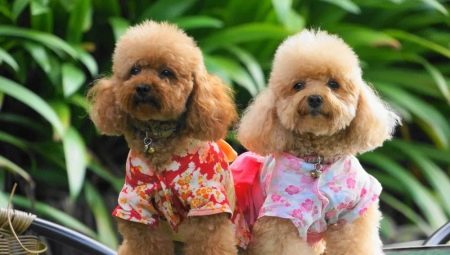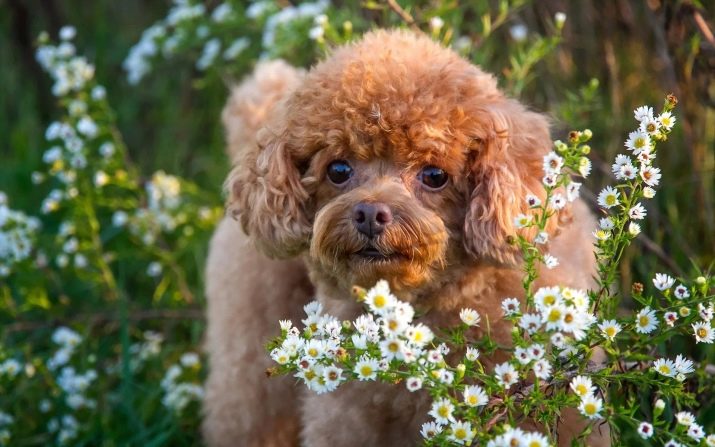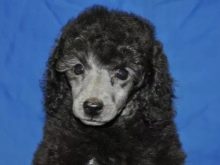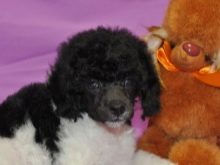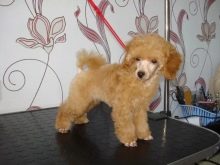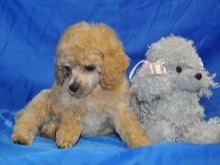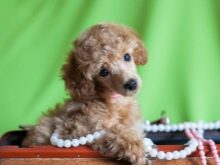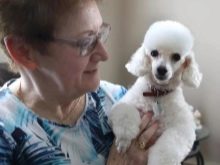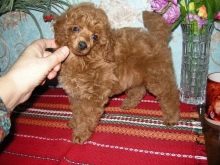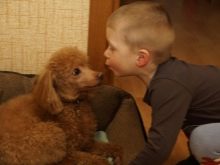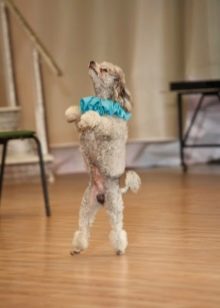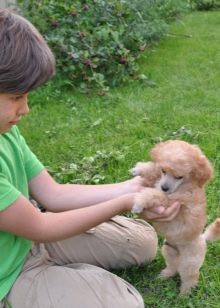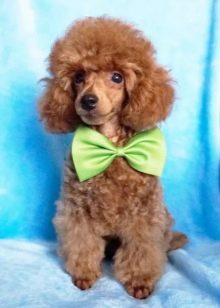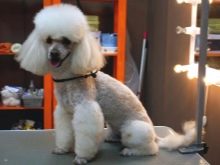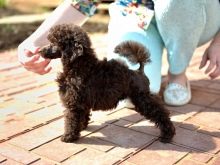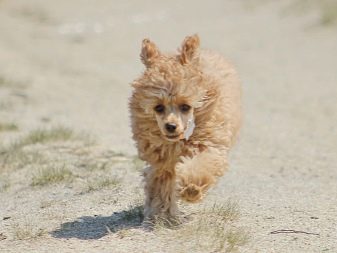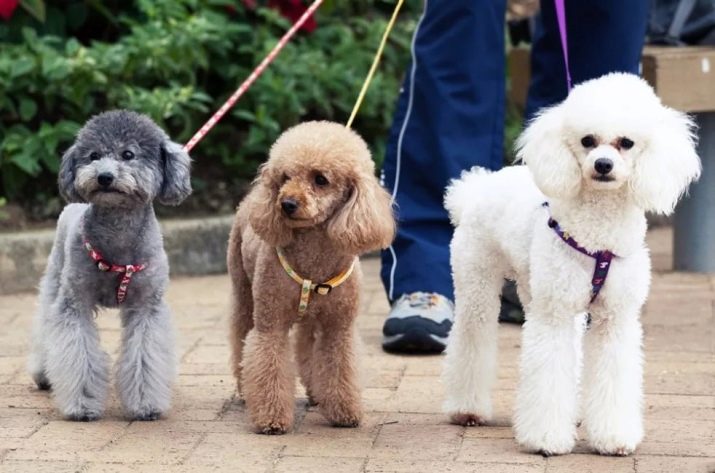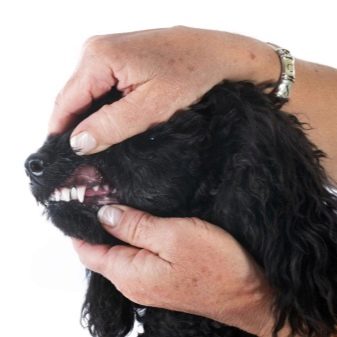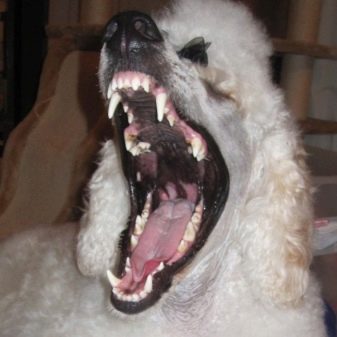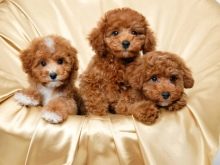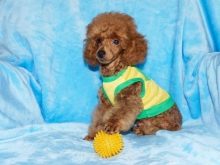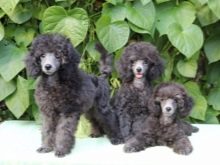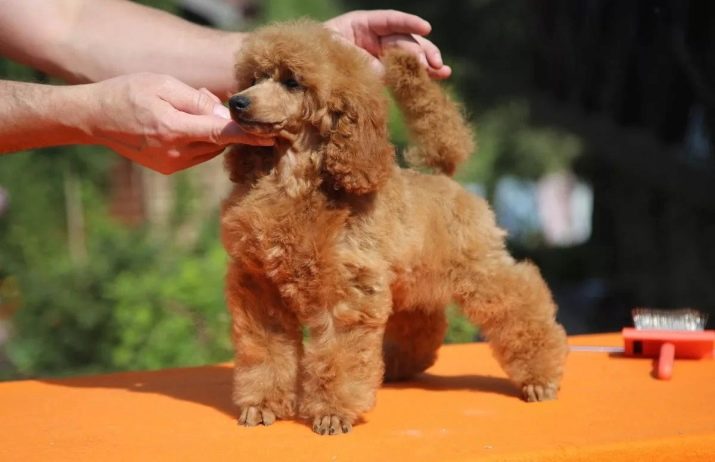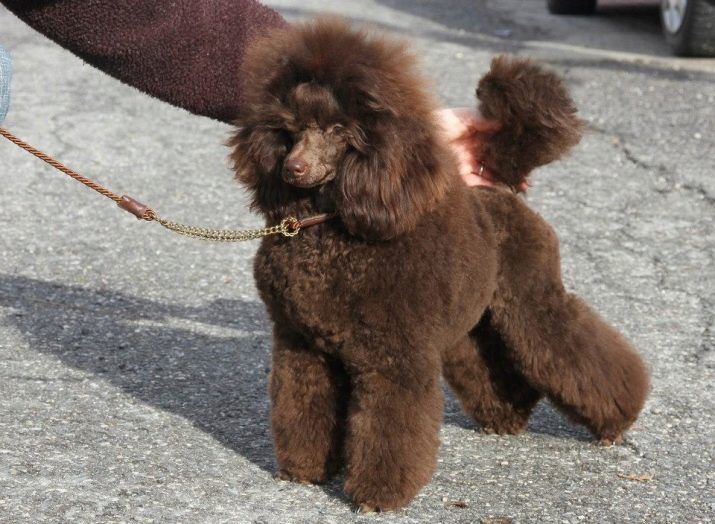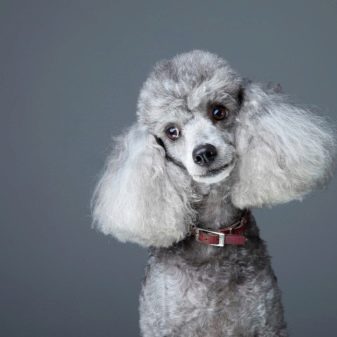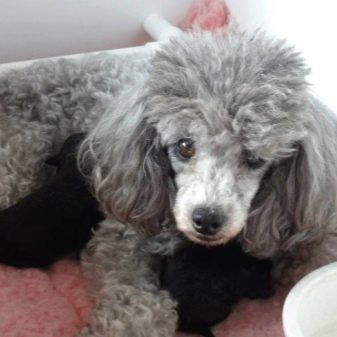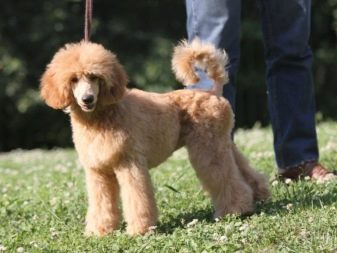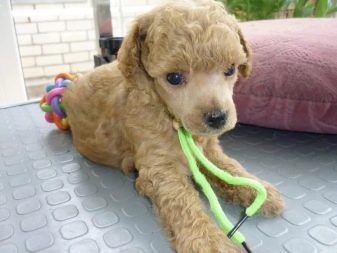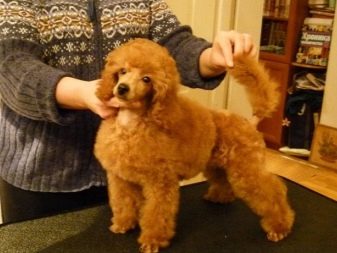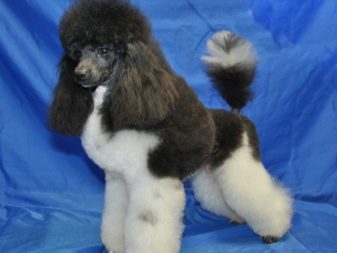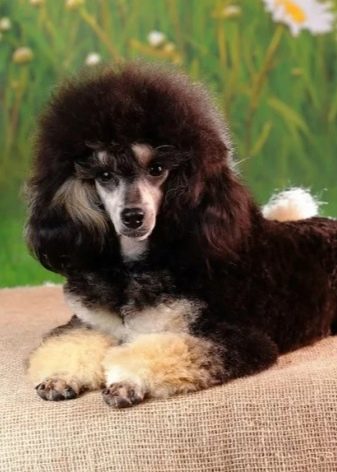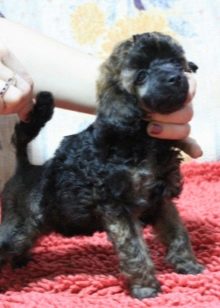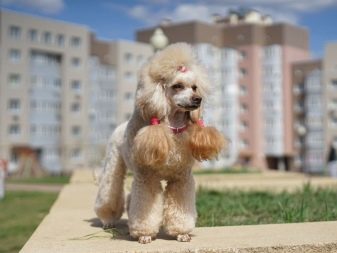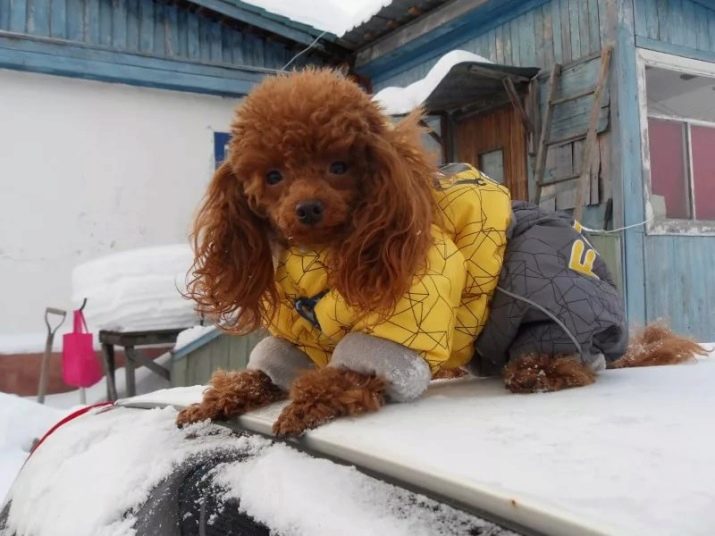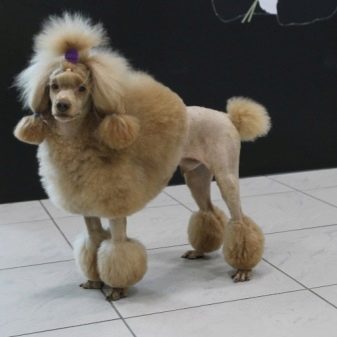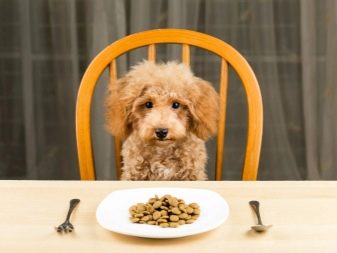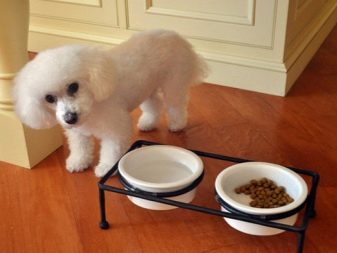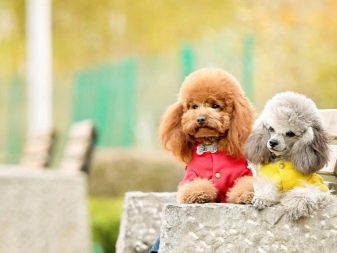For many years the miniature poodle retains one of the leading positions among the decorative breeds of dogs. These intelligent animals have a good character, demonstrate excellent ability to train, suitable for keeping as companions for children and the elderly. The pros and cons of the breed often cause heated debate among breeders and just lovers. Choosing a miniature poodle, there is no doubt: this pet will definitely not let its owner be bored.
History of origin
The dwarf poodle is a breed bred on the basis of the classic royal variety of these dogs. The exact history of their origin today is quite difficult to trace. Among the alleged ancestors even divers are mentioned, as well as representatives of shepherd's, hunting breeds. The first mention of the prototypes of modern poodles is considered to be works of painting of the XIII century. It was on the canvases of the masters of the time that it was possible to meet dogs that look very similar to their curly descendants.
Initially, in France, the breed was called caniche, from cane - "duck", and was associated with the hunting use of these animals in the production of waterfowl. The love of water is also reflected in the name of dwarf poodles in other countries - here they are often called derivatives of the word “splash”. And in Germany, such dogs were called pudel-nass - literally “soaked to the skin”.
When breeding a dwarf variety, the emphasis was no longer on the working qualities of animals, but on their decorativeness and visual appeal.
The prefix "royal" ancestor of dwarf poodles also received by chance. Dogs with an unusual appearance were available only to nobles and royal ladies. The royal life lasted for more than one century - the commoners did not have the opportunity to start the same animals as the powerful ones of the world.
Mini-versions of poodles appeared only in the XIX century thanks to the efforts of the famous Swiss scientist by the name of Shaytlin. Small dogs not only retained the main breed characteristics, but also remained proportionally folded. The miniature version of the dog received recognition, and with it the first officially registered description in 1880. But the selection of the dwarf poodle lasted until 1936. However, the very first standard, approved in France, is considered by canonical today as breeders and judges rely on exhibitions when evaluating the external data of breeding animals.
Breed description
Characteristics of the breed dwarf poodle allows you to fully appreciate all its features. Even puppies already have pronounced signs that allow to determine their affiliation to breeding animals. Dogs have a strong constitution without excess grace, are miniature repetition of their standard fellow, require similar care and attention.
The standard parameters inherent in the dwarf poodle are as follows.
- Body weight in the range of 4-6 kg. At the same time, the animal must have a strong constitution, which distinguishes it from the version that has an elegant skeleton.
- Height at withers 28-35 cm for an adult animal with a fully formed bone.
- The head of the correct form, without distortion of proportions, the occipital protuberance is moderately pronounced.A characteristic feature is the presence of a groove, longitudinally passing from the neck to the back of the nose, it can be felt, even if visually this sign is not visible.
- Muzzle without evidence of apparent weakness or massiveness. The jaws are well developed, the coat of coat gives them a U-shape. The correctness of the silhouette, according to the standard, is determined not by the silhouette of the jaw bones, but by the edges of the lips. They have a contrasting pigment (black) or tonal coat, pink spots are not considered marriage. Bite scissor, standard, tooth-white enamel, without yellow spots and chips.
- The nose with a lobe is medium in size, the nostrils are dilated, the color corresponds to the tone of the coat and lips.
- The eyes are small, with a slight slant of the inner corner. In the French version of the standard, the shade of the iris is indicated as almost black, but taking into account the variety of shades of coat, an amber or dark brown tone is allowed.
- The ears are soft, rather thick, on the sides in the upper part adjacent to the head. The lower edge of the ear should reach the corners of the lips according to the standard, but the lack of length is not considered a gross defect. The measurement is made without regard to the length of the coat.
- The body is strong, slightly elongated, close in shape to the regular rectangle.
- The neck is oval, the withers are almost not expressed, the neck is clearly defined, well developed.
- The croup is rounded, the lumbar region is strong, the back is short, slightly narrowed to the femoral region.
- Well-defined oval chest, wide, reaching the elbow joints. The belly emphasizes the grace of the silhouette, taut. Highly located tail, the standard allows both natural length and arresting of the tip. In motion, he should be carried high, without bends. The breed standard indicates a flaw that leads to culling - this is the complete absence of a tail, a tail tail.
- The limbs are straight, without distortion and curvature, the hind legs are muscular, the hock is springy.
When buying an animal for purebred breeding and participation in exhibitions, be sure to choose the animals that most meet the standard from parents with a pronounced phenotype inherited by the offspring.
Character
The description of the character of mini-poodles allows you to get a more complete picture of this cheerful creation. The hardy dwarf dogs possess a huge stock of natural cheerfulness and almost never lose their presence of mind. Poodles of this type are great for participating in competitions - they have no equal in jumping disciplines, agility. But it is worth remembering that the lack of movement in combination with abundant nutrition rather quickly leads an active and mobile pet to obesity.
High intelligence is a characteristic feature of this popular breed. Easily and quickly assimilating even the most complex teams, dwarf poodles rightfully deserve the title of the most capable of learning. Moreover, animals react sensitively enough even to changes in the mood of the owner and do not impose their society if it is not in the spirit.
If the family needs a pet that can adapt to the mode of the owner's day and share his interests, dwarf poodles will be the ideal choice.
But such a dog is not a toy, but a full-fledged companion, always ready to support an active game. Dwarf poodles are suitable for children of school age and adults, but the kid is better not to choose such a dog. Aggression against a puppy can lead to mental problems.
The presence in the house of other pets can lead to jealousy from the dwarf poodle. These miniature dogs do not get along well with their own kind, preferring to them a society of people. The sense of danger causes the puppy and adult dog to show anxiety, alertness towards strangers. But with people well known to them, dwarf poodles get along well.
A clear voice and a willingness to show it to others for any reason is one of the features of the breed. Dogs bark from an excess of feelings and from fright, loudly express their discontent. For the owner, such sociability may be a problem, but then no guest or occasional visitor will be left without attention.
Do not forget about hunting instincts - while walking the dog is actively interested in the outside world and may well bring prey. In addition, the dog swims well and loves to be in the open water.
Advantages and disadvantages
Dwarf poodles, like other dog breeds, have their advantages and disadvantages. The advantages of the breed traditionally include:
- lack of a specific smell of an animal emanating from the coat;
- the possibility of content in the house where people who suffer from allergic reactions live;
- good trainability;
- high intelligence;
- the genetic absence of aggression, cowardice — individuals exhibiting these qualities are simply rejected.
No cost and no cons. Dwarf poodles, as owners of abundant coat, require great attention to self-care. Dogs require a groomer or a haircut at home. In preparation for exhibitions, the cost of this increase significantly. Another important point - the frequent and loud barking, which is virtually impossible to cope with. It is especially difficult to disaccustom the barking of young dogs - they are much more emotionally excitable than members of other breeds.
The sensitivity of animals is manifested in the perception of the environment. Dwarf poodles rather negatively react to a high level of noise, an unfavorable emotional background in a house or apartment. Aggression against an animal can also negatively affect its behavior.
A change of owner is not recommended for dogs of this breed, they are faithful, do not like change.
In addition, in the absence of proper attention, a pet may show signs of depression, sadness. This can also be attributed to shortcomings. People who are not at home for a long time, it is better to consider another version of the pet.
Poor health, typical of most dwarf breeds, has not bypassed the poodle. Dogs with improper feeding often suffer from diabetes, they have epilepsy, hearing impairment, vision problems.
How long do dogs live?
The dog Snoopy, who managed to celebrate his 20th birthday, is considered the champion among his fellow breed. But usually the life of the animal is somewhat shorter - about 12-15 years.
Heredity can affect a pet’s longevity - the absence of genetic diseases allows you to eliminate the possible premature death of a dog For the miniature poodle, also such moment as physical activity is of great importance.
Reducing the amount of movement for a small dog is an extremely dangerous phenomenon, since the breed is prone to obesity.
A growing number of owners of non-breeding animals agree on the advisability of castration or sterilization of pets. Such a cardinal decision is usually associated with high risks of cancer. To prevent their development on the reproductive organs, an operation is carried out.
It is worth noting that The dwarf poodle is a rare example of a dog with a tendency to longevity. The owners who pay pet health enough attention, the animal will feel great in 15-17 years. There is also a lack of a tendency to early aging. Up to 10-12 years, the animal retains physical activity and does not lose its shape.
If the exact date of birth of the dwarf poodle is unknown, it can be determined approximately by the state of the teeth. Young animals 1-2 years old have snow-white enamel, a pointed tooth shape with protrusions in the shape of a trefoil.In a 4-year-old dog, the state of the teeth changes - they acquire a grayish color, the protruding parts disappear, smooth out.
From the age of 5, fangs begin to wear off, and the enamel itself gradually turns yellow. The 8-year-old animal already has not too sharp teeth, traces of significant abrasion are visible. During this period there is an intensive formation of tartar, plaque, which requires intensive attention of the veterinarian. By the age of 10, the dog's teeth are completely yellow, sometimes they turn brown. After another 2 years there is a loosening of the dentition, changing the bite.
How old do they grow?
The size of the dwarf poodle depends largely on the age and sex of the pet. In small puppies, weight and height change quite dynamically:
- Monthly puppy weighs about 10% of the body weight of an adult dog;
- from 2 to 4 months gain in weight is up to 100% from the previous value monthly;
- A 3-month-old puppy should weigh about 2.5-2.9 kg and grow to 23.5 cm at the withers;
- in the period from 4 to 6 months puppies go into the junior category, body weight reaches 3-4 kg with growth from 27 cm;
- 7 months - an important milestone in the life of a puppy, at this age and up to a year he reaches maximum weight and height.
Up to 1.5 years, the dwarf poodle forms completely. At this point, the animal can grow another 2-3 cm, gaining the final parameters: about 6 kg in weight and 33-35 cm at the withers. Dogs stop growing rapidly on reaching the age of the first heat and the moment of puberty. After this, the parameters of the dwarf poodle practically do not change.
Types of color
Dwarf poodle, as well as larger or smaller representatives of this breed group, can have one of two types of coat. The first is curly, soft enough, with a pronounced curl, voluminous and fluffy. The second version of the coat - corded, in which the strands gather into a kind of twisted cords with a length of at least 20 cm. The structure of the wool in this case is more dense, heavy, looks more impressive.
Regardless of the type of wool, it should not be coarse or tough. Ostev hair well keeps the shape of a haircut.
An important feature of the coat of dwarf poodles is the absence of molting. In the process of grooming you have to pay a lot of attention.
Among the colors provided by the standard, there are several.
- The black. The classic version, the most common. It is characterized by high quality wool, this color does not provide for any lighter shades in certain areas of wool, only deep anthracite. Should not be visible white areas of the guard hair (except for gray hair).
The skin of the dwarf poodle in this case should have a gray or bluish tint, eyes and pigmentation in open areas dark brown.
- White. Newborn puppies of this color are allowed to have orange-pink or cream-colored spots in the chest, legs, and ears. As they grow older, dogs become completely snow white. The skin of white dwarf poodles has a pink or truffle color in the form of spotted patches. Karimi eyes remain, edging around them, nose, claws are always exceptionally black.
- Brown. This color is also called chocolate, it is characterized by the purity of the color range without impregnation of a light brown or beige shade. The color of the nose lobe is dark liver, amber or brown eyes.
As the dog matures, the color “fades”, loses its intensity.
- Silver / gray. It should be clean, without the predominance of black or white tone. Silver or gray color can have many shades, it is fully formed upon reaching three years of age, skin tone corresponds to the color of the coat. Newborn puppies have a black tone, he begins to change to 6 weeks of age.The first signs of silver color appear on the face and legs, while the eyes are necessarily brown, and all pigmentation is black.
- Apricot. The coat color with this color may be more or less intense, but it should not turn into white or chocolate. The hair on the ears may be darker than the base color of the body. In the first two years, the animal has a more saturated tone, rather peach, but then it brightens and can even become creamy-cream. Skin tone - pink, white, gray, blue-gray version is allowed, pigmented areas are black or brown, eyes are always only brown.
- Auburn / Red. The color of their wool has the characteristic color of mahogany or casts of copper. Red color, like all other bright shades of wool, over time loses its intensity. The skin is colored in bold hair, the pigmented patches are dark brown, the nose is black or a bit of dark chocolate, the eyes are brown or light brown.
- Red brown. Combines the shades of two colors and looks very decorative.
But over time, the saturation of the tone of the wool changes and only the professionals can determine the belonging of the poodle to the rare color.
- Harlequin. This color is characterized by the presence of a white background, which occupies about 60% of the body area, and a contrasting black “cap” on the head, as well as “blankets” on the dog's back.
Harlequin dwarf poodles are most often obtained by mixing white animals with pigmented skin and black or gray producers with a spotting gene.
- Tan or black and tan, there is also a brown, red, gray basic background. Dark wool occupies about 80% of the body, the markings are localized on the chest, the edges of the ears, the eyebrows, the muzzle, in the anal area, on the surface of the paws.
Since 2007, the harlequin, tan and red-brown colors are recognized by the RKF Champion as official, but at the international level they are welcome far from everywhere. Among the "pioneers" of the introduction of new shades of wool are dog handlers and breeders from the Czech Republic, the USA, and Germany. The cost of dogs of exotic color is always higher than the classic.
Such perspective colors of dwarf poodles as tiger, sable, silver-beige, splash or merle are spotted as yet unrecognized as the standard.
Content Features
Caring for a poodle does not require special skills, but implies the regularity of all procedures. In particular, while preserving the fluffy coat, the pet requires daily thorough combing. In the absence of timely care, wool is knitted into mats. Non-show dogs should be hygienically trimmed on a regular basis, at least twice a year. They bathe the pet 6 times a year or as the coat is polluted.
The dwarf poodle, despite its decorative status, is a rather active dog that needs a splash of energy. For her are required daily double walks in the morning and evening hours. In addition, the pet is taken annually to a veterinarian to receive preventive vaccinations, as well as to clean the enamel surface from tartar.
Daily procedures should include examination of the eyes, teeth, ears of the animal. Experts also recommend paying attention to nail clipping - representatives of decorative rocks, they often grind down insufficiently, so they need additional pruning.
It is important to understand that the dwarf poodle is a dog exclusively for home keeping. It adapts easily to the space of a small apartment, and to the interior of a country house.
The dog has no developed undercoat, it can not spend a long time outdoors at low temperatures.For the winter period for short-cropped pets, it is recommended to purchase special overalls, allowing to provide additional heat, to eliminate contact with moisture and dirt.
Owners of dwarf poodles have to pay great attention to creating a neat haircut on the pet's hair. For exhibition copies only the following options are allowed.
- English haircut. The dog retains only fluffy batons on the hind limbs. The rest of the hair is cut short.
- Under the lion. The loin and the back of the body is cut short. The front of the body retains a fluffy mane. On the tail also remains a fluffy tassel.
- Modern With this type of haircut, hair is shortly clipped over the entire surface of the body, its length is maintained only on the head in the form of a “cap” and on the surface of the tail.
Care of the hair of the dwarf poodle is done using a furminator or a special machine. For the show haircut does a professional groomer.
What to feed?
The standard diet of the miniature poodle should include a complete set of vitamins, minerals, nutrients. The best solution would be the selection of finished premium feed for dogs of small breeds. If an animal is purchased in a nursery, it is highly likely that it will already be accustomed to a specific type of finished product. It is important to adhere to the optimal menu to prevent obesity, to which all dwarf poodles are prone.
When feeding with natural food, the dog should not be given leftovers from the master's table. It will have to prepare a special meal that includes the following ingredients:
- lean meats - chicken, beef (it can be offered raw), boneless turkey;
- saltwater fish - cooked, only fillet, is given twice a week;
- fresh and boiled vegetables, with the exception of legumes;
- cereals - buckwheat porridge, rice, cooked without salt, with a small addition of vegetable oil;
- fresh greens - nettle, dandelion leaves;
- fruits - dwarf poodles with pleasure eat slices of bananas and apples;
- eggs - up to 2 pieces per week, fit chicken, quail;
- fermented milk products - cottage cheese, yogurt, puppies can be given whole milk.
Regardless of the peculiarities of the diet, the miniature poodle must have round-the-clock access to clean fresh water, it is regularly changed.
The choice of dishes should take into account the growth of the dog. It is better to choose options for bowls on special stands.
Owner reviews
The dwarf poodle is a breed that causes real delight in both adults and children. Owner reviews most often mention the extraordinary intellectual abilities of these small dogs. But during the walk you need to prepare for the need to protect the pet from the immoderate attention of others and large relatives.
A great advantage of the dwarf poodle is the absence of a molting period, the smell of wool. Despite the rather lush fur coat, the dog is suitable even for allergies and allows you to keep furniture and other interior items clean. Attractive appearance and the ability to vary the appearance of the pet are also noted by the owners as important breed advantages.
In addition, the dwarf poodles are incredibly photogenic - they can be used in photo shoots, advertising, always receiving rave reviews about the four-legged model.
Often, male owners initially consider the breed to be too “female”, but after talking with the animals closer, they radically change their mind. The dwarf poodle is not just a favorite, but a real aristocrat, always ready to demonstrate bravery and intellectual abilities. Thanks to the fast learning of the teams, the dog is suitable for children as a companion for walking or getting the first experience of self-training of animals.
About the features of the breed, see below.
